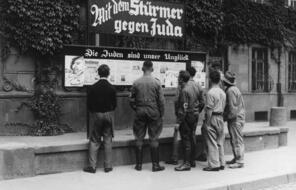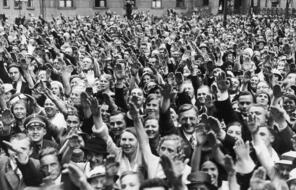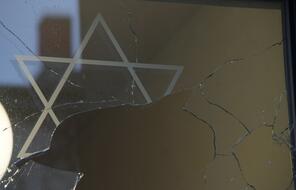Terezín: A Site for Deception
At a Glance
Language
English — USSubject
- History
- The Holocaust
- Propaganda
As the war progressed, the Nazis wanted to deport more and more Jews to the east. To do so, they decided to convert Terezín, a former prison north of Prague, Czechoslovakia, into a transit ghetto-camp. Terezín, or Theresienstadt, as the Germans called it, was unique in that it did not fit the definition of a concentration camp or a ghetto; it was used both as a way-station for those being sent to other camps farther east and as a place to house specific populations of Jews, including decorated veterans of World War I, the elderly, and prominent individuals whose disappearance might be widely reported or who would be unfit for forced labor. The inmates included a number of famous poets, painters, musicians, composers, and scholars. Partly for this reason, Terezín had an unusual number of cultural activities for adults and children; some artwork and music created there survived the war.
Facades for the International Commission by Bedrich Fritta
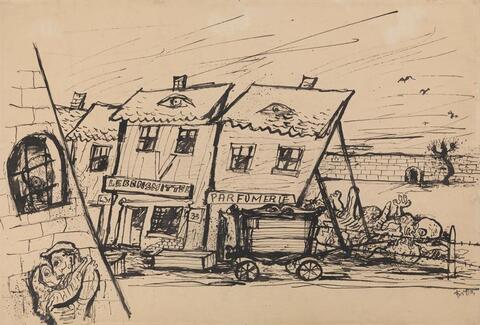
Facades for the International Commission by Bedrich Fritta
This illustration by Bedrich Fritta, a prisoner at Terezín, depicts the “beautification” of the ghetto-camp undertaken by the SS before the Red Cross visit in 1944.
In 1944, in response to pressure from Denmark after the deportation of Danish Jews to Terezín, the Nazis invited the Danish Red Cross, the Danish foreign minister, and the International Red Cross to inspect the camp. Before the visitors arrived, prisoners were ordered to pave streets, repair housing, build a playground, and even plant 1,200 rosebushes. The Nazis also deported 7,500 young men and women to Auschwitz to make the camp less crowded and to substantiate their claim that it was a ghetto for old people. In this way, Terezín became a propaganda tool to hide what was really happening to the Jews.
Arnošt Lustig, who was an inmate at Terezín at the time, later recalled:
Flowers and Butterfly by Margit Koretzova
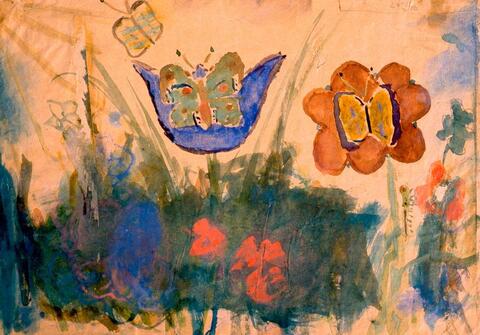
Flowers and Butterfly by Margit Koretzova
Margit Koretzova painted this while imprisoned at the Terezín ghetto-camp, and died at age ten. Children were chiefly remembered by their creativity while at Terezín.
For the Red Cross visit, even the SS Scharfuhrer [squad leader] Rudolph Haindl was nice to the children for the benefit of the camera . . . he posed for the camera, smiling, and not insisting that he be greeted by Jews from a distance of three steps, as he had demanded just the day before. The town was improved for the purpose of filming and also for the visit by the Danish Red Cross—a request that had been supported by the Swedish government. Jewish women even had to brush the pavement with their hair brushes to help get things ready. The city square, where once there had been only military parades, was transformed into a garden with a musical stage. The city temporarily took on the appearance of a seaside resort. Stores were filled with relatively nice things (not, of course, actually for sale—such things were forbidden for prisoners). For a few days there was even a bank that looked like a real bank. The apartments of prominent Jews were furnished with new furniture. So that nothing would be spoiled the Nazis sent their own people as spies to mingle with Jews on the street, disguised as Jews, complete with yellow stars. Kitchens were painted. All types of cultural events were permitted: opera, concerts and operettas such as Die Fledermaus were performed . . . Nurses were given white uniforms . . . 1
The visitors were suitably impressed, and the reports after the visit were positive. Pleased with their success, the Nazis decided to create a “documentary-style” film about Terezín in summer 1944. Kurt Gerron, an inmate who had been a well-known actor and director, was put in charge of the filming of The Führer Gives a City to the Jews, but he was not allowed to edit the film or even view the developed footage. Two weeks after the movie was completed, he and other participants were sent to Auschwitz. Gerron was gassed soon after his arrival.
Despite the facade, Terezín was no paradise. During World War II, more than 140,000 Jews passed through Terezín. About 33,000 died there from malnutrition, disease, and overwork. Many of the rest were shipped to death camps. Fewer than 17,000 survived the war. After the war, some Germans claimed that all they knew about the concentration camps was what they had heard about Terezín. 2
Connection Questions
- Why did the Nazis want to create a “model” ghetto-camp? Why did they want outsiders to see it? What changes did they make to Terezín in preparation for the visit from the International Red Cross?
- Based on what you read about Denmark in the reading Denmark: A Nation Takes Action, why do you think the Danish government was able to persuade the Nazis to let its representatives tour Terezín?
- What impact did Terezín have on those who saw and heard about it?
How to Cite This Reading
Facing History & Ourselves, "Terezín: A Site for Deception," last updated August 2, 2016.
This reading contains text not authored by Facing History & Ourselves. See footnotes for source information.

